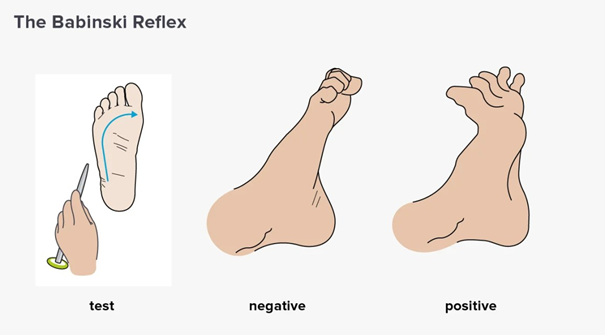The nurse documents an abnormal finding from the Babinski reflex as a (the):
toes turning up and spreading
downward curl of the toes
pain in the big toe
big toe bending upward
The Correct Answer is A
A. Toes turning up and spreading:
This description corresponds to the abnormal finding in the Babinski reflex. In a positive Babinski sign, the big toe (hallux) dorsiflexes (turns upward) and the other toes fan out. This response is abnormal in adults but normal in infants up to a certain age.
B. Downward curl of the toes:
This response is typical of the normal plantar reflex, where the toes curl downward (plantar flexion) in response to stimulation of the sole of the foot. It is not indicative of the Babinski reflex.
C. Pain in the big toe:
Pain in the big toe is not a characteristic finding of the Babinski reflex. The Babinski sign is assessed by observing the movement pattern of the toes in response to stimulation, rather than eliciting pain.
D. Big toe bending upward:
The big toe bending upward, or dorsiflexion of the big toe, is a specific component of the positive Babinski sign. However, it is typically accompanied by spreading of the other toes, which is the hallmark feature of the Babinski reflex.

Nursing Test Bank
Naxlex Comprehensive Predictor Exams
Related Questions
Correct Answer is C
Explanation
A. Lhermitte's sign:
Lhermitte's sign is a neurological symptom characterized by a sensation of electric shock-like pain that radiates down the spine and into the limbs, typically triggered by flexing the neck forward. It is often described as shooting or stabbing pain and is commonly associated with lesions or damage to the cervical spinal cord. Lhermitte's sign is not associated with a tightening sensation around the torso but rather with shooting pain down the spine and limbs.
B. Trigeminal neuralgia:
Trigeminal neuralgia is a neurological condition characterized by severe, shooting pain along the trigeminal nerve, which supplies sensation to the face. The pain is typically triggered by activities such as chewing, speaking, or touching the face. Trigeminal neuralgia causes sudden, intense, electric shock-like pain in the face, particularly in the areas supplied by the trigeminal nerve (e.g., cheek, jaw, forehead). It is not associated with a tightening sensation around the torso.
C. MS hug:
The "MS hug" is a symptom experienced by some individuals with multiple sclerosis, characterized by a sensation of tightness, pressure, or squeezing around the chest, abdomen, or torso. It can feel like a band tightening around the body and may be described as a constricting or girdling sensation. The MS hug is caused by spasms or tightening of the muscles surrounding the rib cage or the intercostal muscles due to damage to the nerves that control muscle function in MS.
D. Paroxysmal spasms:
Paroxysmal spasms refer to sudden, involuntary muscle contractions or spasms that occur intermittently. These spasms can affect various parts of the body and are commonly associated with conditions like multiple sclerosis. However, they typically present as brief, sudden contractions rather than a persistent tightening sensation around the torso.
Correct Answer is D
Explanation
A. Pupil response:
Pupil response refers to the reaction of the pupils to light stimulus. The pupils should normally constrict when exposed to bright light and dilate in dim light. Changes in pupil size or reactivity can indicate alterations in neurological function. For example, unequal or non-reactive pupils (anisocoria or fixed pupils) can be indicative of dysfunction in the cranial nerves or brainstem. However, while pupil response is an important aspect of neurological assessment, it may not always be the earliest indicator of cerebral status changes.
B. Deep tendon reflexes:
Deep tendon reflexes are involuntary muscle contractions in response to stretching of a muscle tendon. These reflexes are assessed by tapping the tendon with a reflex hammer, eliciting a rapid and brief muscle contraction. Changes in deep tendon reflexes can provide information about the integrity of the peripheral nervous system and spinal cord. However, alterations in deep tendon reflexes may occur secondary to changes in cerebral function and are typically assessed along with other neurological signs.
C. Muscle strength:
Muscle strength refers to the force generated by muscles during voluntary movement. It is typically assessed by asking the client to perform specific movements against resistance or by testing the strength of individual muscle groups using standardized scales (e.g., Medical Research Council scale). Changes in muscle strength can occur due to neurological or musculoskeletal conditions. While weakness or paralysis can result from lesions affecting the upper motor neurons (e.g., strokes or spinal cord injuries), alterations in muscle strength may not always be the earliest indicator of cerebral status changes.
D. Level of consciousness:
The level of consciousness refers to the degree of awareness and alertness exhibited by the client. It is assessed by evaluating the client's responsiveness, orientation, and ability to follow commands. Changes in the level of consciousness, such as confusion, lethargy, stupor, or coma, can indicate alterations in cerebral function and are often the earliest indicators of neurological dysfunction. Assessing the level of consciousness is a critical component of neurological examination and helps guide further assessment and management of clients with suspected brain tumors or other neurological conditions.
Whether you are a student looking to ace your exams or a practicing nurse seeking to enhance your expertise , our nursing education contents will empower you with the confidence and competence to make a difference in the lives of patients and become a respected leader in the healthcare field.
Visit Naxlex, invest in your future and unlock endless possibilities with our unparalleled nursing education contents today
Report Wrong Answer on the Current Question
Do you disagree with the answer? If yes, what is your expected answer? Explain.
Kindly be descriptive with the issue you are facing.
